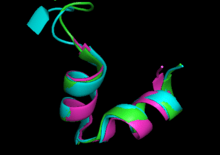TetR
.png)
Tetracycline (tc) is a broad family of antibiotics to which bacteria have evolved resistance. Tc normally kills bacteria by binding to the bacterial ribosome and halting protein synthesis. The expression of tc resistance genes is regulated by Tet Repressor Protein, called TetR. More specifically, TetR represses the expression of TetA, a membrane protein that pumps out substances toxic to the bacteria, by binding the TetA operator.[1] In tc resistant bacteria, TetA will pump out tc before it can bind to the ribosome. Therefore, TetR may have an important role in helping scientists to better understand mechanisms of antibiotic resistance and how to treat antibiotic resistant bacteria. TetR is one of many proteins in the TetR protein family, which is so named because TetR is the most well characterized member.
TetR is used in artificially engineered gene regulatory networks because of its capacity for fine regulation. In the absence of tc, basal expression of TetR is very low, but expression rises sharply in the presence of even a minute quantity of tc through a positive feedback mechanism. TetA is also present in the widely used E. coli cloning vector pBR322 (where the sequence that confers resistance, containing only the TetA gene,[2] is also often referred to as TetR).
Structure & Function
.png)
TetR functions as a homodimer.[1] Each monomer consists of ten alpha helices connected by loops and turns. The overall structure of TetR can be broken down into two DNA-binding domains (one per monomer) and a regulatory core, which is responsible for tetracycline recognition and dimerization. TetR dimerizes by making hydrophobic contacts within the regulatory core. There is a binding cavity for tetracycline in the outer helices of the regulatory domain. When tetracycline binds this cavity, it causes a conformational change that affects the DNA-binding domain so that TetR is no longer able to bind DNA. As a result, TetA and TetR are expressed. There is still some debate in the field whether tetracycline derivatives alone can cause this conformational change or whether tetracycline must be in complex with magnesium to bind TetR.[3] (TetR typically binds tetracycline-Mg2+ complexes inside bacteria, but TetR binding to tetracycline alone has been observed in vitro.)
.png)
The DNA-binding domains of TetR recognize a 15 base pair palindromic sequence of the TetA operator.[1][4] These domains mainly consist of a helix-turn-helix (HTH) motif that is common in TetR protein family members (see below). However, the N-terminal residues preceding this motif have also been shown to be important for DNA binding.[5] Although these residues do not directly contact the DNA, they pack against the HTH and this packing is essential for binding. The HTH motifs have mostly hydrophobic interactions with major grooves of the target DNA.[1] Binding of TetR to its target DNA sequence causes changes in both the DNA and TetR.[6] TetR causes widening of the major grooves as well as kinking of the DNA; one helix of the HTH motif of TetR adopts a 310 helical turn as the result of complex DNA interactions.
TetR Protein Family

As of December 2004, this family of proteins has about 2,353 members that are transcriptional regulators.[1] (Transcriptional regulators control gene expression.) These proteins contain a helix-turn-helix (HTH) motif that is the DNA-binding domain. The second helix is considered to be most important for DNA sequence specificity and often recognizes nucleic acids within the major groove of the double helix.[6] In the majority of the family members, this motif is on the N-terminal end of the protein and is highly conserved.[1] The high conservation of the HTH motif is not observed for the other domains of the protein. The differences observed in these other regulatory domains are likely due to differences in the molecules that each family member senses.
TetR protein family members are mostly transcriptional repressors, meaning that they prevent the expression of certain genes at the DNA level. These proteins can act on genes with various functions including antibiotic resistance, biosynthesis and metabolism, bacterial pathogenesis, and response to cell stress.
See also
References
- 1 2 3 4 5 6 Ramos, Juan L.; Martínez-Bueno, Manuel; Molina-Henares, Antonio J.; Terán, Wilson; Watanabe, Kazuya; Zhang, Xiaodong; Gallegos, María Trinidad; Brennan, Richard; Tobes, Raquel (2005-06-01). "The TetR Family of Transcriptional Repressors". Microbiology and Molecular Biology Reviews. 69 (2): 326–356. doi:10.1128/MMBR.69.2.326-356.2005. ISSN 1092-2172. PMC 1197418
 . PMID 15944459.
. PMID 15944459. - ↑ Allard, John D.; Bertrand, Kevin P. (January 29, 1992). "Membrane Topology of the pBR322 Tetracycline Resistance Protein". The Journal of Biological Chemistry. 267 (25).
- ↑ Werten, Sebastiaan; Dalm, Daniela; Palm, Gottfried Julius; Grimm, Christopher Cornelius; Hinrichs, Winfried (2014-12-23). "Tetracycline Repressor Allostery Does Not Depend on Divalent Metal Recognition". Biochemistry. 53 (50): 7990–7998. doi:10.1021/bi5012805. ISSN 0006-2960.
- ↑ Saenger, Wolfram; Hinrichs, Winfried; Orth, Peter; Schnappinger, Dirk; Hillen, Wolfgang. "Nature Citation". Nature Structural Biology. 7 (3): 215–219. doi:10.1038/73324.
- ↑ Berens, C.; Altschmied, L.; Hillen, W. (1992-01-25). "The role of the N terminus in Tet repressor for tet operator binding determined by a mutational analysis.". Journal of Biological Chemistry. 267 (3): 1945–1952. ISSN 0021-9258. PMID 1309804.
- 1 2 Huffman, Joy L; Brennan, Richard G (2002-02-01). "Prokaryotic transcription regulators: more than just the helix-turn-helix motif". Current Opinion in Structural Biology. 12 (1): 98–106. doi:10.1016/S0959-440X(02)00295-6.
- Ramos et al. (2005) Microbiol. Mol. Biol. Rev, 69, 326-356.
- Berens et al. (1992) JBC, 267, 1945-1952